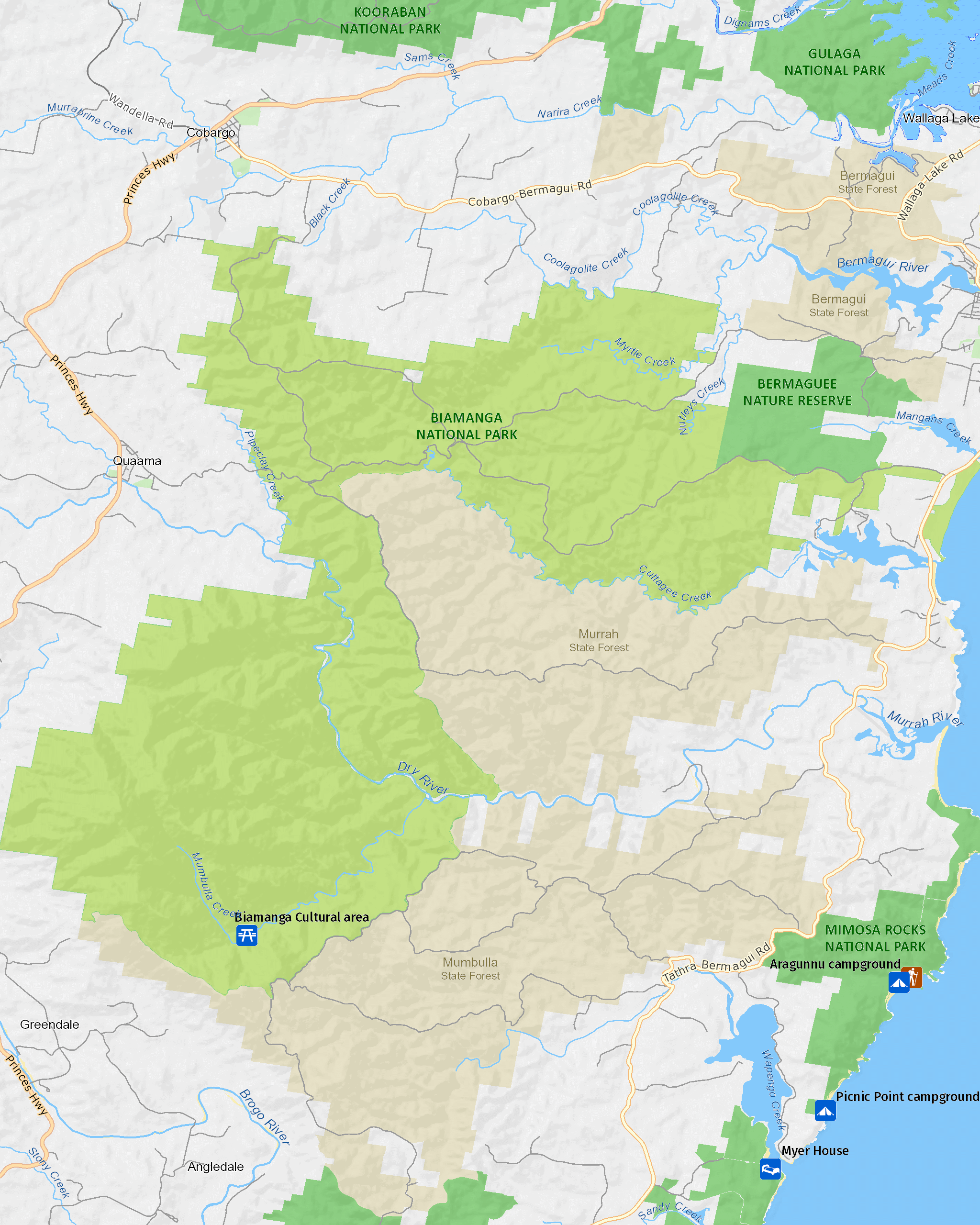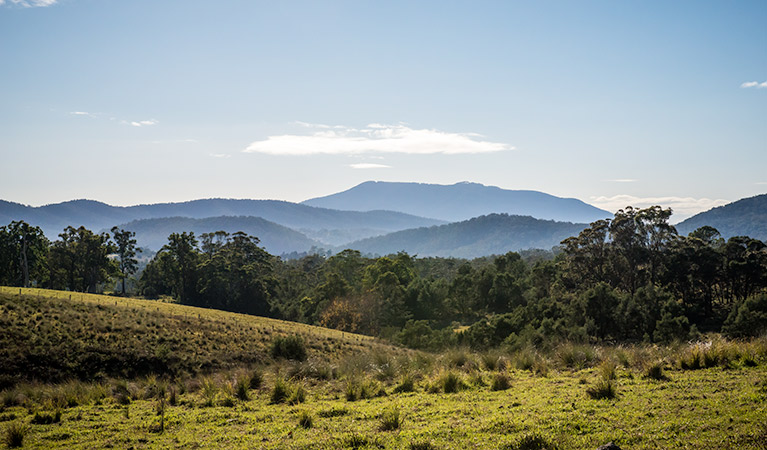Biamanga National Park
Overview
Jointly managed by Aboriginal people and the NPWS, Biamanga National Park (bi-a-man-ga) is a significant Aboriginal site filled with dramatic landscapes and places to unwind.
Read more about Biamanga National Park
Sacred to the local Aboriginal Yuin People for centuries, in May 2006 Biamanga National Park was returned to its traditional custodians as part of a joint management agreement with NSW National Parks. What does this mean? It means that when you visit the park, you're visiting a place where decisions about the land are made by Aboriginal people. You're also visiting Aboriginal Country, where the mountains meet the sea and the landscape connects Aboriginal culture and lore. A visit here is both special and unique.
The first thing that strikes you is a sense of remoteness and solitude: though only 20km from the town of Bega, Biamanga National Park is a wild landscape of cascades and granite boulders, ribbon gums and gurgling creeks, not far from the Tasman Sea. Not only does the park feature Biamanga (also known as Mumbulla Mountain) and dramatic river gorges fed by natural springs, it also contains an important area of unmodified coastal foothill habitat. Environmentally speaking, a trip through Biamanga National Park is a step back in time.
There are great opportunities for birdwatching in the park, with species like the azure kingfisher often frolicking in the park. Lookouts provide scenic vantage points, easily reached by short walks suitable for children, and lots of picnic spots mean you can spend an entire afternoon just soaking up the atmosphere. Visiting Biamanga National Park is the perfect way to explore Aboriginal history on the NSW Far South Coast, and offers plenty of reasons to have you coming back time and time again.
Local alerts
For the latest updates on fires, closures and other alerts in this area, see https://www.nationalparks.nsw.gov.au/visit-a-park/parks/biamanga-national-park/local-alerts
Contact
- in the South Coast region
Biamanga National Park is always open, but may have to close at times due to poor weather or fire danger.
-
-
Narooma office
02 4476 0800
Contact hours: Monday to Friday, 9am to 4pm. Office open by appointment only. Closed public holidays. - 10 Graham Street, Narooma NSW 2546
-
Email: npws.eurobodalla@environment.nsw.gov.au
-
Narooma office
Visitor info
All the practical information you need to know about Biamanga National Park.
Map

Map legend

Maps and downloads
Nearby towns
Bega (24 km)
With its forests, lush pastures and a coastline sculpted into a succession of wonders by the sea, the Sapphire Coast is a perfect holiday destination at any time of the year. Set in a valley at the junction of the Bega and Brogo rivers and surrounded by rich dairy country, Bega is a handsome, historic town that's the rural centre of the Sapphire Coast and gateway to the lush Bega Valley. Visit the Bega Cheese Heritage Centre, housed in a faithful reproduction of the original, tells the story of cheese-making production in the area.
Bermagui (57 km)
Bermagui is a colourful port, famous for its deep-sea fishing. It's on the estuary of the Bermagui River, close to national parks.
Eden (76 km)
Eden is a historic whaling town, ideal for a whale-watch tour. It's built around a promontory that juts into Twofold Bay.
Learn more
Biamanga National Park is a special place. Here are just some of the reasons why:
Yuin Country

The landscape of Biamanga National Park is sacred to the Yuin People, ancient custodians of this land, who maintain their strong traditional ties to it today. In 2006, the park became jointly managed by the Aboriginal community and NPWS. There are a number of cultural sites throughout the area with spiritual significance for the Yuin. The best place to learn about these is Mumbulla Creek Falls, where interpretative signs detail the Aboriginal history of the region.
- Biamanga Cultural area Biamanga Cultural area offers visitors to Biamanga National Park a scenic place to picnic and enjoy the short walk to a lookout with views over Mumbulla Falls and a beautiful gorge.
Volcanic legacy

Biamanga (also known as Mumbulla Mountain) rises in the middle of Biamanga National Park, and is largely the legacy of an ancient shield volcano. You can see this most clearly through a granitic creek corridor with massive boulders and plunge pools. This is the course of Mumbulla Creek, which rushes toward the coast from its origins up in the mountain. This park conserves an important area of substantially pristine coastal foothill environments, with monkey and ribbon gums clustered around the creekbeds. It also contains the endangered chefs cap correa, an unusual lemon and green flower that looks exactly like its namesake. The shrubs are endemic to NSW and popular with local birds.
- Biamanga Cultural area Biamanga Cultural area offers visitors to Biamanga National Park a scenic place to picnic and enjoy the short walk to a lookout with views over Mumbulla Falls and a beautiful gorge.
A precious haven

Biamanga National Park conserves an important area of substantially pristine coastal foothill environments, with monkey and ribbon gums clustered around the creekbeds. It also contains the endangered chefs cap correa, an unusual lemon and green flower that looks exactly like its namesake. The shrubs are endemic to NSW and popular with local birds. The park is also home to an array of wildlife, from goannas and eastern water dragons to swamp wallabies and some of the last remaining koalas in the south-eastern corner of NSW. Birds are also plentiful, including lyrebirds, azure kingfishers, flycatchers and blue wrens.
Education resources (1)
What we're doing
Biamanga National Park has management strategies in place to protect and conserve the values of this park. View the detailed park and fire management documents.

